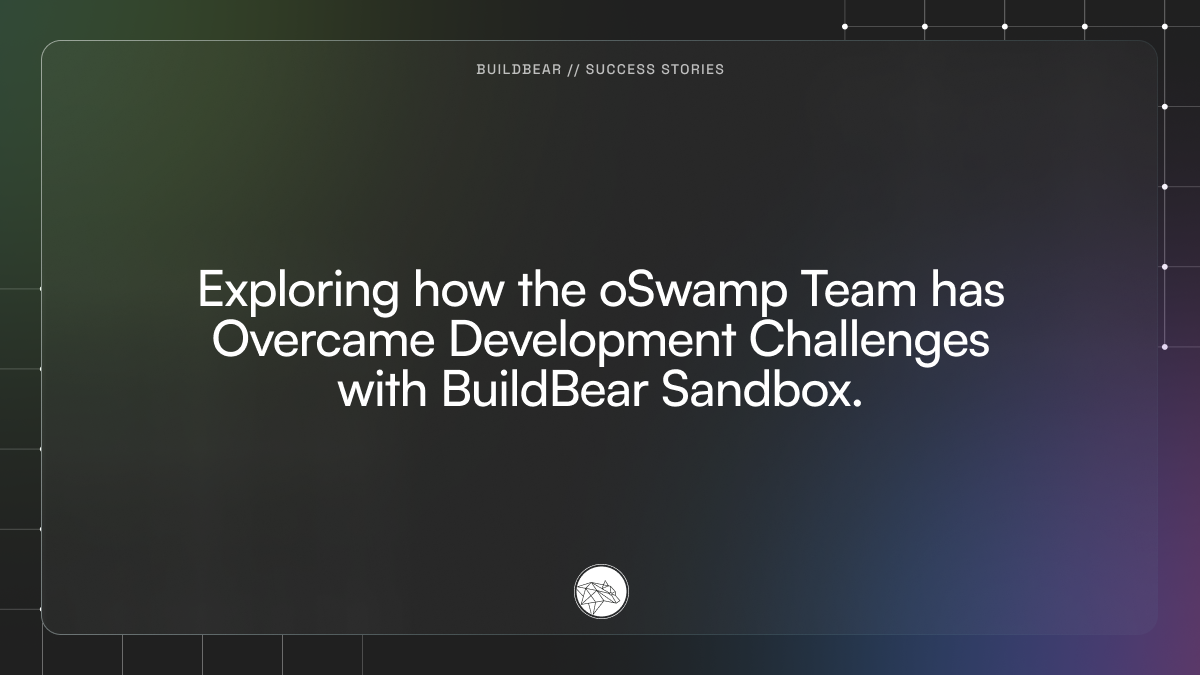Exploring How the oSwamp Team has Overcame Development Challenges with BuildBear Sandbox.
 BuildBear
BuildBear
oSwamp is constructed upon the Swamp contract, developed by the Overline Network team, with the aim of aiding community members in efficiently managing their boats.
In the future, oSwamp Contracts will be launched based on the Swamp contracts, and oSwamp will utilize the original swamp contract for ownership.
Link to the Project: Swamp-map
About Luiz R. Rodrigues:
Luiz R. Rodrigues is an experienced full-stack developer with proficiency in GitHub, backend development, REST, GraphQL, API, frontend development, Node.js, and Amazon Web Services.
Luiz R. Rodrigues is currently a freelancer developer.
Challenges Faced by oSwamp:
Mainnet Testing! The Challenge of Re-establishing Protocols As the oswap contracts rely on the swamp contracts on the Mainnet, it is imperative to have the Mainnet state. Setting up the Mainnet state of the swamp contract on the Testnet is not only burdensome but also extremely time-consuming.
Token Scarcity: Obtaining a sufficient quantity of Testnet tokens for thorough testing proves to be a time-consuming task.
Transaction Confirmation: Slow! Public Testnets are not designed for instant transaction processing, and in practice, they often experience lengthy transaction times, occasionally lasting up to 13.5 seconds. These delays can pose challenges, especially during the contract testing phase, as they can impede the overall development process.
Explorer Limitations: Unfortunately, detailed monitoring of local Hardhat Testnet transitions is not possible. The absence of an explorer for observing transitions within the local Hardhat Testnet presents challenges when debugging unsuccessful transactions.
Account Impersonation: Public Testnets are intentionally designed to prevent the impersonation of other accounts, which limits testing possibilities and hampers comprehensive testing.
Integration with BuildBear:
Luiz R. Rodrigues has integrated BuildBear into his workflow to address these challenges, seeking a solution.
Key Feature Leveraged:
Mainnet State: BuildBear enables the forking of Mainnet and rapid spin-up of the Sandbox within seconds. This capability allows for effective testing of the application in conjunction with Mainnet protocols, eliminating the need to set up any mock environments.
BuildBear Faucet: Through the BuildBear Faucet, Luiz R. Rodrigues gained immediate access to native and popular ERC20 tokens, eliminating the need for manual token accumulation.
Instant confirmation: BuildBear allows standard test scripts involving 10 transactions to be completed in less than 26 seconds. On public Testnets (such as Sepolia), the same process can take over 2 minutes. This faster transaction processing reduces the time spent on running contract test scripts, enabling quicker iterations and accelerated progress.
Explorer: The BuildBear explorer simplifies the process of monitoring transactions and debugging failed transactions, thanks to BuildBear’s built-in transaction tracer.
Account Impersonation: This feature enables Luiz R. Rodrigues to mimic other existing wallets and perform transactions from those accounts.
Impact of Using BuildBear in his own words:
I don’t know any other way to make my project testing possible without Buildbear Mainnet fork, without this only possible if spend a lot of money in Mainnet transactions/fee.
Are you a team of developers working on an innovative DApp? What are you waiting for? Utilize BuildBear to accelerate your development process.
Spend your valuable time building your product while we take care of the rest.
Subscribe to my newsletter
Read articles from BuildBear directly inside your inbox. Subscribe to the newsletter, and don't miss out.
Written by

BuildBear
BuildBear
BuildBear is a platform for testing dApps at scale, for teams. It provides users with their own private Testnet to test their smart contracts and dApps, which can be forked from any EVM chain. It also provides a Faucet, Explorer, and RPC for testing purposes.